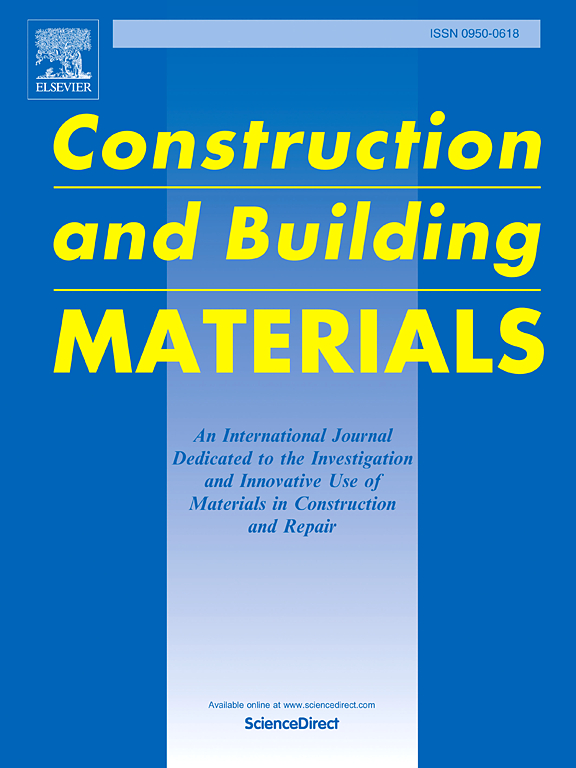盐冻融循环作用下工程胶凝复合材料耐久性评价
IF 8
1区 工程技术
Q1 CONSTRUCTION & BUILDING TECHNOLOGY
引用次数: 0
摘要
本研究旨在探讨盐冻融循环作用下工程胶凝复合材料(ECC)耐久性和力学性能的演化机制。然后进行了多尺度实验程序,以评估ECC的表面损伤,微观结构特征和压缩性能的时间依赖性变化。试验结果表明,随着循环次数的增加,ECC宏观损伤表现出明显的空间演化特征——从表面开始(浆体剥落),向内推进(纤维-基质粘结层暴露),循环次数达到100次为临界阈值。盐冻融效应促进了ECC内过渡孔隙向大孔隙的转变,并分析了其动态演化机制。值得注意的是,在高循环数下,盐溶液的物理相变主导了孔隙的扩张。循环200次后,ECC的单轴抗压强度和弹性模量分别下降约29.34 %和36.70 %。纤维-基体界面结合强度的退化使ECC的抗压韧性从强度控制行为转变为变形控制行为,主要是由于界面处的粘结-滑移响应转变为摩擦-滑移响应。最后,采用弹塑性三相球模型建立了退化模型,该模型可以很好地预测ECC在不同孔隙度下的残余抗压强度。本研究结果可为寒区和盐碱地混凝土结构的维护和加固提供有价值的技术见解和理论基础。本文章由计算机程序翻译,如有差异,请以英文原文为准。
Durability evaluation of engineered cementitious composite subjected to salt freeze-thaw cycles
This study aimed to investigate the evolution mechanisms of durability and mechanical properties of engineered cementitious composites (ECC) under the salt freeze-thaw cycle. A multi-scale experimental program was then carried out to evaluate the time-dependent variations in surface damage, microstructural characteristics, and compressive performance of ECC. The test results revealed that the macroscopic damage of ECC exhibited distinct spatial evolution-initiating at the surface (slurry spalling) and advancing inward (fiber-matrix bond layer exposure) as the cycle number climbed, with 100 cycles identified as a critical threshold. The salt freeze-thaw effect promoted the transformation of transition pores within ECC into macropores, and a dynamic evolution mechanism was analyzed. Notably, the physical phase changes of the salt solution dominated the pore expansion at a high cycle number. After 200 cycles, the uniaxial compressive strength and elastic modulus of ECC decreased by approximately 29.34 % and 36.70 %, respectively. The degradation of fiber-matrix interfacial bonding strength shifted the compressive toughness of ECC from strength-controlled to deformation-controlled behavior, primarily due to the transition from bond-slip to friction-slip response at the interface. Finally, a degradation model was developed using an elastoplastic three-phase sphere model, which could be used to predict the residual compressive strength of ECC at varying porosity levels well. The findings of this study can provide valuable technical insights and theoretical foundations for the maintenance and strengthening of concrete structures in cold and saline regions.
求助全文
通过发布文献求助,成功后即可免费获取论文全文。
去求助
来源期刊

Construction and Building Materials
工程技术-材料科学:综合
CiteScore
13.80
自引率
21.60%
发文量
3632
审稿时长
82 days
期刊介绍:
Construction and Building Materials offers an international platform for sharing innovative and original research and development in the realm of construction and building materials, along with their practical applications in new projects and repair practices. The journal publishes a diverse array of pioneering research and application papers, detailing laboratory investigations and, to a limited extent, numerical analyses or reports on full-scale projects. Multi-part papers are discouraged.
Additionally, Construction and Building Materials features comprehensive case studies and insightful review articles that contribute to new insights in the field. Our focus is on papers related to construction materials, excluding those on structural engineering, geotechnics, and unbound highway layers. Covered materials and technologies encompass cement, concrete reinforcement, bricks and mortars, additives, corrosion technology, ceramics, timber, steel, polymers, glass fibers, recycled materials, bamboo, rammed earth, non-conventional building materials, bituminous materials, and applications in railway materials.
 求助内容:
求助内容: 应助结果提醒方式:
应助结果提醒方式:


